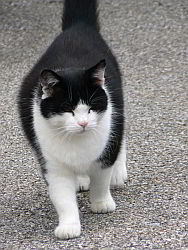(many thanks to benipop at sxc.hu for the original fat cat photo)
Why are So Many Pet Owners Allowing Their Companions to Get Fat?
Banfield Pet Hospital recently released their State of Pet Health 2012 Report, and the news isn’t good. In fact, it’s extremely troubling.
Chronic diseases in cats and dogs have risen dramatically over the last five years.
The report is a compilation of medical data from about 2 million dogs and over 400,000 cats that visited a Banfield hospital in 2011.
Some of the disturbing findings:
- Overweight and obesity increased in dogs by 37 percent, and in cats by a stunning 90 percent
- Arthritis increased 38 percent in dogs and 67 percent in cats
- Almost half of arthritic dogs and more than a third of arthritic cats are also overweight
- Nearly half of diabetic dogs and cats are overweight
- Forty percent of dogs with hypertension and 60 percent with hypothyroidism are overweight
Banfield also conducted a survey of 2,000 dog and cat owners to see what steps they were taking to keep their pets healthy. Survey answers revealed that less than 40 percent of dog owners and only a quarter of cat owners planned to seek advice from a veterinarian to manage their pet’s health condition.
Your Fat Pet is (or will soon be) a Sick Pet
Clearly, overweight and obesity in pets today is both its own disease and the root cause of many other diseases that develop as the result of too much weight.
I wish more pet owners understood the consequences of letting their dog or cat get fat. I find it hard to believe most pet parents would continue to overfeed, feed the wrong foods, and under-exercise their companion animals if they realized they were destroying their pet’s health.
In addition to arthritis, diabetes, hypertension and hypothyroidism as mentioned above, obesity also causes respiratory problems, kidney disease, and a significant reduction in both quantity and quality of life.
Dr. Ernie Ward of the Association for Pet Obesity Prevention (APOP) considers a major contributing factor to be commercial pet food and treats, and I absolutely agree.
I also agree with Dr. Ward when he states, “Pet obesity is plainly a people problem, not a pet problem. The most important decision pet owners make each day regarding their pet’s health is what they choose to feed it.”
I wish dogs and cats could talk. I wish they could look up from their bowls overflowing with pet junk food and say, “Please don’t do this to me. Please help me eat a balanced, species-appropriate diet – the kind of food I’d eat if I had a choice. Please don’t tempt me with too much food, or too many treats. Please? I depend on you.”
A Simple Formula for Getting the Weight Off Your Dog or Cat
Regular readers here at Mercola Healthy Pets know I often repeat these three steps when I talk about pet weight loss. That’s because, very simply, they work.
Getting your dog or cat down to a healthy weight isn’t rocket science. It involves three uncomplicated steps:
- Feed a balanced, species-appropriate diet. Skip all the commercial weight control and ‘low fat’ diets. Regardless of her weight, your dog or cat still needs the right nutrition for her species, which means food that is high in animal protein and moisture, with low or no grain content.
- Practice portion control — usually a morning and evening meal, carefully measured. A high protein, low carb diet with the right amount of calories for weight loss, controlled through the portions you feed, is what will take the weight off your dog or cat. And don’t forget to factor in any calories from treats.
- Regularly exercise your pet. An overweight body gets back in shape by taking in fewer calories and expending more energy. Daily exercise, including at least 20 minutes of consistent aerobic activity, will help your pet burn fat and increase muscle tone.
This is Cal the Beagle, one of Dr. Becker’s patients…
Cal was a rescue dog who arrived at his new home obese and depressed.
His proactive owner transitioned him to a balanced, species-appropriate raw food diet.
Cal slimmed down on his own. He’s lost 10 pounds!
For more details and step-by-step help on getting your pet down to a healthy weight, see either Valuable Tips for Helping Your Heavy Cat, or if you’re a dog owner, How to Help Your Chunky Dog Release Excess Pounds.
————————————————————
This article was published on Dr Karen Becker’s website, and you can see the original, here. Her website has lots of info for animal lovers, and an excellent newsletter, too. Well worth a visit ![]()


